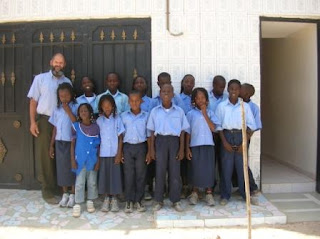


Jig Jum is a local historian and has traced the genealogy of Ngone's ethnic group, the Serere-Safin, back 28 generations. The Serere-Safin origins are with those who fled slavery in Egypt around 600 BC. A famous Senegalese historian (http://en.wikipedia.org/wiki/Cheikh_Anta_Diop) argued that the Wolof ethnic group of Senegal are true descendants of the pharoahs of ancient Egypt (check out that link for a fascinating discussion of his originally very controversial theories). However Jig Jum contends that it was not the Wolof but the Serere-Safin who are the true descendants of the pharoahs. The Wolof ethnic group was created as a combination of languages only around the year 1300. But the Serere, Bambara and Peul of the surrounding region of West Africa are true descendants who fled Egypt around 600 BC, and also more truly exhibit the respectful practices of the ancient culture. The Serere and Peul were of the same origins and lived along the Senegal River in northern Senegal until a group explored down to the coast south of the cap vert peninsula of Dakar, where they reached the Atlantic Ocean, stopped, and became the Serere-Safin. The oldest dated fossilized bones in Senegal are from the Serere-Safin region.
Jig Jum, Ngone's brother Abibou, and I visited a remote Serere-Safin village named Sipan to look at an agriculture project initiated by a missionary. After visiting the vegetable field we walked on out to the Baobab forest you see above. Ngone had explained to me that Baobab trees are the homes of the spirits, or ghosts. We looked out at dozens of mounds dotted throughout the forest. The elders explained to me the traditional burial process:
Up until a few years ago the Serere-Safin buried the richest amongst them in buried pyramids. They buried a person's home and belongings with them and each village would then come with all the men piling on a whole lot of sand all day long. At the end of the day that village would sacrifice a cow giving its blood to the spirits (drip into the earth), the meat for the villagers to eat, and place the cow's head at the top of the mound. Then another village would come the next day and repeat the ritual placing another cow's head at the top of the mound, until the mound grew larger and larger.
More about Pharoahs
Ngone, Kathleen Aiza and David Ibrahima's genealogy


























